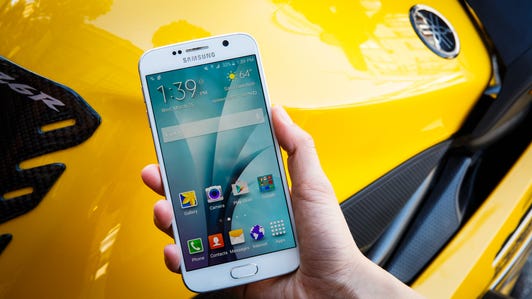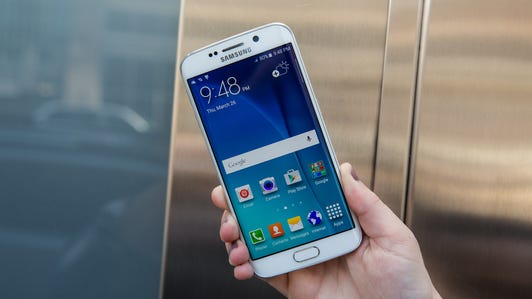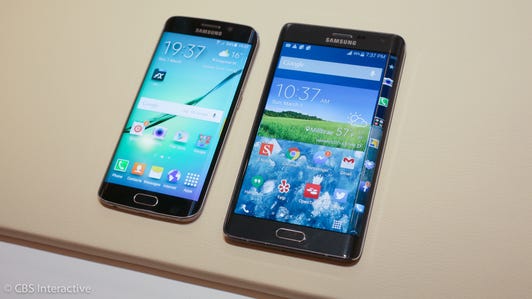
Sarah Tew/CNET
Samsung, set to debut new models of its top-of-the-line smartphone, needs to offer a design that convinces people to do something they didn’t do the last time the Galaxy was updated: buy them.
After leading the smartphone market for the past four years, Samsung has seen its profit slide as customers have defected to rival Xiaomi in China, Micromax in India and Apple nearly everywhere else. In the global smartphone market, Samsung tied with Apple as the No. 1 vendor in the fourth quarter of 2014 — a competitor it had crushed not too long ago.
With the new Galaxy S6, set to debut on Sunday at Mobile World Congress in Barcelona, Samsung is expected to deliver two versions of the smartphone that incorporate sleeker materials, like metal, versus its previous plastic designs. And at least one model is believed to sport a curved display that wraps around the sides of the device. The South Korean electronics maker may also unveil a mobile payments service that rivals the Apple Pay service introduced last year along with the iPhone 6 and 6 Plus.
See also
- Samsung buys LoopPay, all but confirming new Apple Pay rival
- CNET’s Galaxy S6 rumor roundup
- Tune into CNET’s Galaxy S6 live blog
Overall, the smartphones are expected to be a drastic upgrade from its current Galaxy S5, which was snubbed by reviewers — and consumers — for being too similar to the S4. For Samsung to reclaim its position, or at least stop its freefall, it needs to offer something different. And even more than that, Samsung has to prove it’s listening to what consumers want — sleeker designs, less bloatware and software features people actually use.
“This new device is absolutely critical in terms of getting momentum going again, turning things around and proving Samsung has still got it and can deliver a killer device,” said Jan Dawson, an analyst with Jackdaw Research.
Samsung’s rise
Even before Samsung launched its popular Galaxy S3 in early 2012, the company was already riding high in the mobile phone market. The Galaxy S2, released the year before, helped Samsung take the crown from Nokia as the world’s biggest cellphone vendor in the first quarter of 2012.
With the Galaxy S3, its market share skyrocketed. The device was available at all US carriers at the same time — something very rare at the time. Rather than rely on wireless providers to promote its products in return for exclusive agreements, Samsung persuaded the major carriers to sell the S3 even though they knew rivals would get the phone as well.
It didn’t show the carriers the device in advance but shared its marketing plans, helping the carriers feel like they were part of the S3 rollout while Samsung shouldered most of the burden for pushing its device. Ultimately, having the same smartphone at all carriers at once helped Samsung create a focused marketing campaign around a single product — yes, the way Apple does — and it’s a model now emulated by HTC and LG.
Fully metal Samsung Galaxy S6 looks sharp (pictures)






While the Galaxy S4 in 2013 looked similar to its predecessor, it sported more bells and whistles, including a TV control app and a built-in translation tool. There was also software that tracks users’ eye movement to control the device, such as pausing a video when the user looks away from the screen. Samsung is believed to have sold about 40 million units of the device in the first six months on the market, a slightly slower pace than Galaxy S3 sales.
At the same time, Samsung pioneered so-called phablets — large-screen devices serving as phone-tablet hybrids. Though 2011’s 5.3-inch Galaxy Note, was initially mocked for an almost comically large display, the bigger-screen phone appealed to consumers, especially in Asian markets. There was a begrudging acceptance of the Note 2 in the market in 2012 and eager anticipation for the Note 3 in 2013 and the Note 4 last year. The Note led to similar big-screen devices from rival handset vendors including HTC and LG. Even Apple, after dismissing phablets, followed suit last September with the 5.5-inch iPhone 6 Plus.


Sarah Tew/CNET
The Note line appealed to buyers in many markets, but the Galaxy S remained Samsung’s most important device. Anticipation for the Galaxy S5 was high heading into the launch a year ago, but the device didn’t live up to the hype — or at least sales didn’t.
Samsung doesn’t disclose device shipments, but reports have said Samsung sold about 40 percent fewer of the Galaxy S5 than the Galaxy S4 in their first few months of availability. And research firm Strategy Analytics estimates Samsung’s smartphone market share fell to 25 percent in 2014 from 32 percent the previous year. In the fourth quarter, Samsung’s slide and Apple’s gain resulted in the two companies sharing the No. 1 spot for the first time since late 2011, with each holding a 20 percent share of the market after selling 74.5 million phones.
“Right now [Samsung is] consistently on a downward trend, and that’s not healthy,” Current Analysis analyst Avi Greengart said. “This is extremely important.”
Samsung’s struggles
Samsung made a tactical error when it decided not to change the design of its flagship Galaxy S phone much over the past three generations. The Galaxy S5 looks nearly identical to 2013’s Galaxy S4 and 2012’s Galaxy S3. Consumers shopping for a phone opted for an older, cheaper model instead of buying the newest and most expensive Samsung smartphone.
The result: Samsung is hurting. The company has posted five consecutive year-over-year declines in quarterly operating profit. In the fourth quarter, the IT and mobile communications division (which includes smartphones) recorded a 64 percent drop in operating profit from the year-earlier period, to 2 trillion won ($1.8 billion). Only 37 percent of Samsung’s operating profits came from its IT and mobile communications business in the December quarter, compared with two-thirds a year earlier.
Apple and the iPhone pose the biggest threats, with the iPhone 6 and iPhone 6 Plus on their way to being two of the best-selling smartphones of all time. And last quarter, they helped Apple deliver the highest quarterly profit of any company — ever. The tally: $18.04 billion for its fiscal first quarter ended in December.


Now playing:
Watch this:
Samsung Galaxy S6, S6 Edge conquer metal and glass
2:10
Apple’s success comes as Samsung faces stronger competition in emerging markets. Smartphone makers Xiaomi, Micromax and Huawei introduced devices with high-end features at low prices. In comparison, Samsung’s strategy has been to to dump older smartphones on the market at low prices. But consumers in emerging markets didn’t want old, inferior technology — especially when Xiaomi and others were offering more compelling devices at the same price.
“Samsung continues to face intense competition from Apple at the higher end of the smartphone market, from Huawei in the middle tiers,and from Xiaomi and others at the entry level,” said Neil Mawston, an analyst with Strategy Analytics.
Because Samsung’s hardware features like bigger screens and NFC technology, which allows users to share data or pay for items by tapping their phones, are no longer unique, the company has looked to software to help it stand out. But it hasn’t offered features users covet. The Galaxy S4 included apps that were considered gimmicks, and Samsung minimized or killed off many of the items with the Galaxy S5. This year’s model is expected to go a step further, with Samsung preloading less bloatware — the name given to the software features — on its devices. Instead, buyers will be able to choose whether to download Samsung’s apps or not.
And Samsung plans to be more thoughtful with the software and services it includes on its devices. That likely will include a mobile payments service. In mid-February, the company acquired LoopPay, a startup whose technology turns existing card magnetic strip readers into contactless payment receivers. That makes it easy for retailers to accept mobile payments without changing their existing point-of-sale terminals, and the LoopPay setup “has the potential to work” in about 90 percent of existing POS terminals, according to Samsung.
Double-edged sword: Samsung’s curved Galaxy S6 Edge (pictures)






By comparison, Apple Pay requires POS terminals to be equipped with NFC (near field communications) chip technology, which allows information to be shared when two devices are held close together. Retailers have to upgrade their systems to take advantage of Apple Pay, Google Wallet and other NFC-based systems.
Samsung expects device sales to improve as it introduces new devices with slimmer designs and flexible displays that allow the screen to wrap around the side of the device. It also expects the expansion of faster 4G LTE wireless networks across the globe and increased interest in emerging markets to help boost sales and profit, Jin-Young Park, vice president of Samsung’s mobile business, said during the company’s earnings report last month. “We are preparing differentiated and innovative products with specialized features,” he said.
And that sets the stage for the Galaxy S6, which like all of Samsung’s other phones in the line is powered by Google’s Android mobile operating system software. Strategy Analytics’ Mawston estimates Samsung will sell more Galaxy S6 units than Galaxy S5 devices in the first year on the market — about 10 percent more, to be precise.
It all comes down to how well the devices look and how well they work with new apps and features, like the anticipated mobile payments service. If the Galaxy S6 doesn’t excite consumers, Samsung risks becoming the next BlackBerry, a once-dominant and innovative phone maker now struggling to survive. That’s a fate no one envies.
Corrected iPhone 6 Plus’s screen size at 11:45 a.m. PT.



